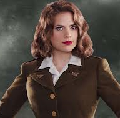Captain America 1
After being deemed unfit for military service,
Steve Rogers volunteers for a top secret research project that turns him into Captain America,
a superhero dedicated to defending USA ideals.
| Actor |
Name |
Morale |
Photograph |
| Chris Evans |
Captain America / Steve Rogers |
Super Soldier |
 |
| Hayley Atwell |
Peggy Carter |
Friend |
 |
| Hugo Weaving |
Johann Schmidt / Red Skull |
Villian |
 |
A shield? Growing up in the 1970s, and first becoming aware of Captain America's crime-fighting career, that shield
always seemed to me the most eccentric and awkward encumbrance to have to carry around all the time – almost an admission of vulnerability,
a superheroic comfort blanket. Granted, it repels any bullet and can be frisbeed around the place as a weapon, but then there's the tiresome
business of having to retrieve it afterwards; it cuts down on hand-to-hand combat and wouldn't some sort of body armour have been frankly more
convenient? It almost looked as if Captain America's loyalty to this faintly ridiculous accessory was a kind of arrogance – that he can defeat
his enemies with one hand in effect behind his back – or even that the shield amounted to a disability, like Daredevil's blindness, for which
his powers were a triumphant, if neurotic over-compensation. But doubt on the subject of the shield, and the Captain generally, is pretty much
allayed by Joe Johnston's cheerfully strident new film version starring Chris Evans, in which his shield is seen to morph from a prototype in
the prefect's-badge shape into the familiar sleek metal disc, like a flattened missile nosecone, which can be slung over the back or the
forearm. The movie cleverly spins a meta-fictional "origin" myth for Captain America: explaining that he was in fact a propagandist comic-book
superhero before becoming a real one. The final scene of the film, and Captain America's very last line, are rather brilliant – though
admittedly less brilliant if their sole purpose is to set up sequels. In his preheroic life, Captain America is Steve Rogers, a plucky,
scrawny bantamweight of a guy, with a body like a plucked and undernourished chicken. In 1941, Steve is desperate to enlist and fight Adolf.
The problem is that he's got a string of illnesses and his physique fails to impress. Then Dr Abraham Erskine (Stanley Tucci) a mysterious
German scientist at a military recruiting station – and a refugee from the Nazis – spots Steve and sees something in his neediness. Steve's
the very guy for an experimental super-growth serum he's got up his white-coated sleeve, and so the conditions are in place to bring Captain
America into the world. The strange thing about the film is that in this early incarnation, Chris Evans's head has clearly been CGI-ed onto
the body of a wimp. In some scenes, from some angles, it appears to be that of a 12-year-old boy. The effect is distinctly creepy, especially
as Evans's face is about 30% too big, like a cartoon character: give him a beagle and a T-shirt with a zig-zag line across it and he could be
Charlie Brown. If he was going to turn out to be a villain, his habitual humiliations and that alien-looking enormous head would make for a
very plausible psychological background, and his subsequent red-white-and-blue colour scheme might suggest the scoundrel's traditional refuge.
But of course Steve becomes a dynamic hero, gruffly indulged by his commanding officer Col. Chester Phillips (Tommy Lee Jones) and falling in
love with a beautiful woman in uniform, Peggy Carter (Hayley Atwell) apparently on loan from British intelligence. The stylish, post-modern
explanation for Captain America's existence is that, once busting out all over with muscles, Steve is given a superhero costume and pressed
into service as an explicitly fictional character, touring with a morale-raising gang-show to raise funds and even starring in a hokey movie
serial. Inevitably, the Captain finds this showbiz imposture irksome and even humiliating, and needs a way to show the world that he can serve
his country and fight the Nazis for real. The film's first act is a smart and inventive phase – perhaps inspired by Clint Eastwood's 2006 film
Flags of Our Fathers, about the Iwo Jima servicemen who were forced to tour around recreating their mythologised "flag-raising" moment in order
to sell war bonds. Afterwards, when Captain America becomes a real superhero, some of the movie's steroidal muscle tone turns to fat. He has
to fight a Nazi villain called Red Skull, played by Hugo Weaving, part of an SS Teutonic cult called the Hydra. This character has been
experimenting with the serum himself, and it turns him into a tandoori-red devil with a Voldemort-like nasal absence. Weaving's German accent
would appear to be a vocal tribute to Christoph Waltz in Tarantino's Inglourious Basterds – I almost wondered if Waltz had actually dubbed the
lines in for Weaving. The clash between the Red Skull and Captain America with his international volunteer force is competently dramatised,
but nothing more. But then comes the strange coda, in which Captain America realises that his destiny as a superhero and a servant of the
state is weirder than he could ever have imagined. Here is where the movie becomes, refreshingly, less wholesome than all that had gone before.
The Captain isn't perfect, but he's the equal of Thor and loads better than the Green Lantern: he's the summer's pre-eminent superhero.
review by
-Peter Bradshaw-
.





